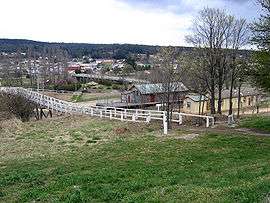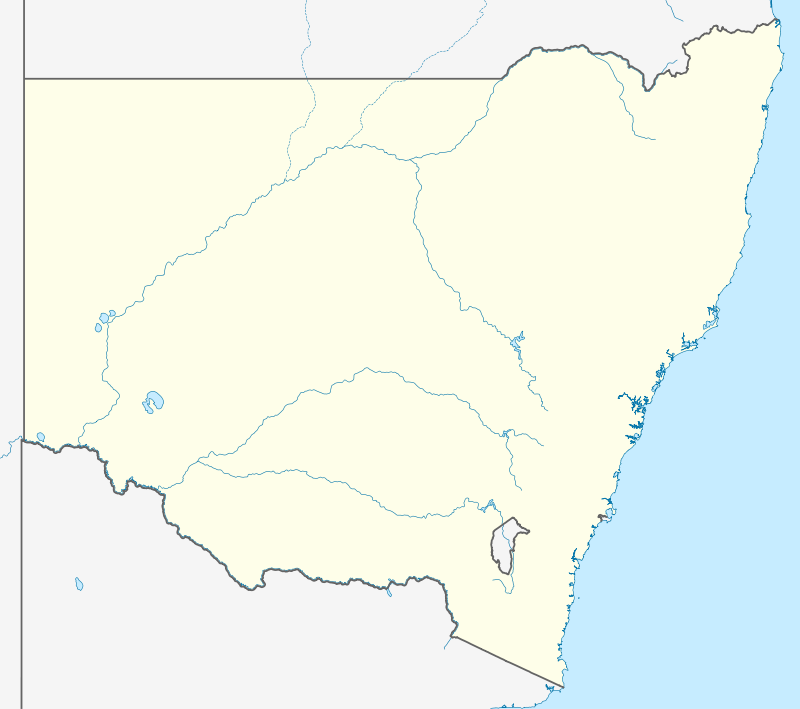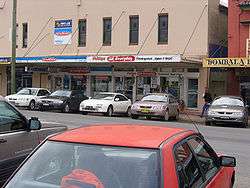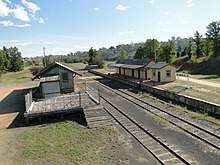Bombala, New South Wales
Bombala is a town in the Monaro region of south-eastern New South Wales, Australia, in Snowy Monaro Regional Council. It is approximately 485 kilometres (301 mi) south of the state capital, Sydney, and 80 kilometres (50 mi) south of the town of Cooma. The name derives from an Aboriginal word meaning "Meeting of the waters".[3] The town lies on the banks of the Bombala River. At the 2016 census, Bombala had a population of 1,387.[1]
| Bombala New South Wales | |||||||||
|---|---|---|---|---|---|---|---|---|---|
 Bombala, looking towards the town centre. The footbridge passes over the Bombala railway line. The right most building is the station building, the centre building the goods shed and above that is the bridge over the Bombala River. | |||||||||
 Bombala | |||||||||
| Coordinates | 36°55′0″S 149°14′0″E | ||||||||
| Population | 1,387 (2016 census)[1] | ||||||||
| Established | 1840s | ||||||||
| Postcode(s) | 2632 | ||||||||
| Elevation | 705 m (2,313 ft)[2] | ||||||||
| Location | |||||||||
| LGA(s) | Snowy Monaro Regional Council | ||||||||
| County | Wellesley | ||||||||
| State electorate(s) | Monaro | ||||||||
| Federal Division(s) | Eden-Monaro | ||||||||
| |||||||||
History
The Bombala area was inhabited by the Ngarigu Aboriginal people prior to the first European settlers arriving in the 1830s. Captain Ronald Campbell established a large property in 1833 that he named 'Bombalo'. More European settlers arrived in the Bombala area in the 1840s during which time the small township developed. Bombala had a post office by 1849 and had a number of large commercial and public buildings by the mid 1850s.[4]
Bombala was proposed in 1903 by King O'Malley as the site of the parliamentary seat of Australia. It was considered as a location because it was half way between the two cities of Sydney and Melbourne. The proposal was ultimately rejected in favour of Canberra.
The town lies on the banks of the Bombala River and principal industries of the area include grazing and timber. Tourism is also growing in importance to the local economy. There is also a small amount of specialty producers with meat rabbits, lavender and many herbs being grown in the district. Delegate is situated 36 km west of Bombala and The Snowy River March which commenced from Delegate in 1916 went via Bombala to Goulburn.
The timber industry has slowly begun to overtake many of the historic properties surrounding Bombala, such as the more-than-150-year-old property of Aston, 10 kilometres (6.2 mi) south-west of the township.
The area is known for possibly the largest population of Platypus in New South Wales and is promoted as Platypus Country.
The Holy Transfiguration Monastery is a male monastic community of the Russian Orthodox Church Abroad. Founded in 1982, the monastic community presided over by Abbott Hieromonk Sergius, abides in the pristine and rugged valley of the MacLaughlin River situated between Cooma and Bombala.[5]
The Facebook page "Bombala History in Photos" contains a wealth of information about the town's history.[6]
Heritage listings
Bombala has a number of heritage-listed sites, including:
- Goulburn-Bombala railway: Bombala railway station[7]
- 91 Main Road: Crankies Plain Bridge[8]
Population
In the 2016 Census, there were 1,387 people in Bombala. 85.1% of people were born in Australia and 89.9% of people spoke only English at home. The most common responses for religion were Anglican 34.6%, Catholic 23.8% and No Religion 20.3%.[1]
Geography and climate

Situated at 705 metres above sea level on the eastern edge of the Monaro Tablelands, Bombala is known for its cold winters with frequent frost and occasional snow. A few kilometres to the east, the land slopes downwards to the South Coast, a flat coastal plain where summers are warmer and winter temperatures much milder. Examples are towns such as Bega and Merimbula, both about 80 kilometres east of Bombala; however, their climates are vastly different from Bombala's. According to Köppen climate classification scheme, Bombala has a subtropical highland climate (Cfb).
Most rain in the area falls as either thunderstorms in summer, or with cold fronts in winter. Extreme temperatures have ranged from 40.7 °C (105.6 °F) to −10.0 °C (14.0 °F).
| Climate data for Bombala | |||||||||||||
|---|---|---|---|---|---|---|---|---|---|---|---|---|---|
| Month | Jan | Feb | Mar | Apr | May | Jun | Jul | Aug | Sep | Oct | Nov | Dec | Year |
| Record high °C (°F) | 40.0 (104.0) |
40.7 (105.3) |
36.4 (97.5) |
30.9 (87.6) |
26.7 (80.1) |
22.1 (71.8) |
18.8 (65.8) |
24.5 (76.1) |
29.0 (84.2) |
31.5 (88.7) |
36.9 (98.4) |
38.5 (101.3) |
40.7 (105.3) |
| Average high °C (°F) | 25.5 (77.9) |
25.0 (77.0) |
22.6 (72.7) |
18.5 (65.3) |
14.7 (58.5) |
11.5 (52.7) |
11.0 (51.8) |
12.7 (54.9) |
15.8 (60.4) |
18.8 (65.8) |
21.2 (70.2) |
23.8 (74.8) |
18.4 (65.1) |
| Average low °C (°F) | 10.3 (50.5) |
10.5 (50.9) |
8.6 (47.5) |
5.2 (41.4) |
2.0 (35.6) |
−0.2 (31.6) |
−1.2 (29.8) |
−0.2 (31.6) |
2.2 (36.0) |
4.7 (40.5) |
6.9 (44.4) |
8.8 (47.8) |
4.8 (40.6) |
| Record low °C (°F) | 0.4 (32.7) |
1.3 (34.3) |
−0.2 (31.6) |
−5.0 (23.0) |
−7.1 (19.2) |
−10.0 (14.0) |
−9.6 (14.7) |
−8.0 (17.6) |
−6.4 (20.5) |
−4.7 (23.5) |
−2.0 (28.4) |
−0.4 (31.3) |
−10.0 (14.0) |
| Average precipitation mm (inches) | 63.2 (2.49) |
59.1 (2.33) |
60.3 (2.37) |
45.0 (1.77) |
43.6 (1.72) |
59.4 (2.34) |
46.1 (1.81) |
40.2 (1.58) |
44.1 (1.74) |
55.2 (2.17) |
64.3 (2.53) |
63.6 (2.50) |
644.1 (25.35) |
| Average rainy days (≥ 0.2mm) | 8.0 | 7.6 | 8.2 | 8.0 | 9.1 | 10.2 | 9.3 | 9.9 | 10.2 | 10.2 | 9.7 | 9.0 | 109.4 |
| Source: Bureau of Meteorology[9] | |||||||||||||
Transport

The railway reached Bombala in 1921 and closed in 1986.[10] being an extension of the line from Queanbeyan to Cooma. The line was and still is known as the Goulburn to Bombala line. During the 1970s, service was provided by a small rail bus, taking 4 hours to cover the 100 kilometres (62 mi) between Cooma and Bombala.
The Monaro Highway (now route B23) which runs from Canberra to Cann River (Victoria) passes through Bombala. Other major roads include Mt Darragh Rd which connects to Pambula and Merimbula on the NSW South Coast.
The nearest airport with regular air services is at Merimbula, 85 kilometres (53 mi) to the east.
Notable residents
- Minard Crommelin MBE (1881-1972), postmistress and environmental conservationist, born at Aston Station, near Bombala.
- Michael Farrell (1965-), contemporary poet and magazine editor, born in Bombala.
- Sir Alexander George William "Bill" Keys AC, OBE, MC (1923-2000), long-serving president of the Returned and Services League (RSL), grew up in Bombala.
- Dick Tooth (1929-), former Australian rugby union representative, born in Bombala.
- William Farmer Whyte (1877-1958), journalist and author[11]
- Charles Henry Kerry (1857-1928), photographer[12]
- Wilfred Alexander de Beuzeville (1884-1954), forester[13]
References
- Australian Bureau of Statistics (27 June 2017). "Bombala (State Suburb)". 2016 Census QuickStats. Retrieved 6 July 2017.

- "Climate statistics for Australian locations - Bombala (Therry Street)". Bureau of Meteorology. Retrieved 5 April 2013.
- "Bombala". Geographical Names Register (GNR) of NSW. Geographical Names Board of New South Wales. Retrieved 20 June 2009.

- "Bombala". www.heritageaustralia.com.au. Archived from the original on 6 March 2017. Retrieved 20 August 2016.
- "Archived copy". Archived from the original on 28 April 2015. Retrieved 2 May 2015.CS1 maint: archived copy as title (link)
- "Facebook: Bombala History in Photos".
- "Bombala Railway Station and yard group". New South Wales State Heritage Register. Office of Environment and Heritage. H01091. Retrieved 18 May 2018.
- "Crankies Plain Bridge". New South Wales State Heritage Register. Office of Environment and Heritage. H01466. Retrieved 18 May 2018.
- "BOMBALA (THERRY STREET)". Climate statistics for Australian locations. Bureau of Meteorology. April 2013. Retrieved 23 April 2013.
- "NSWrail.net". Rolfe Bozier, NSWrail.net. Retrieved 7 October 2009.
- Souter, Gavin. "Whyte, William Farmer (1877-1958)". Australian Dictionary of Biography.
- Burke, Keast. "Kerry, Charles Henry (1857-1928)". Australian Dictionary of Biography.
- Carron, L. T. "de Beuzeville, Wilfred Alexander (1884-1954)". Australian Dictionary of Biography.